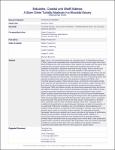A storm driven turbidity maximum in a microtidal estuary
| dc.contributor.author | Postacchini, M | |
| dc.contributor.author | Manning, AJ | |
| dc.contributor.author | Calantoni, J | |
| dc.contributor.author | Smith, JP | |
| dc.contributor.author | Brocchini, M | |
| dc.date.accessioned | 2023-07-03T22:03:23Z | |
| dc.date.available | 2023-07-03T22:03:23Z | |
| dc.date.issued | 2023-08-05 | |
| dc.identifier.issn | 1096-0015 | |
| dc.identifier.issn | 1096-0015 | |
| dc.identifier.other | 108350 | |
| dc.identifier.uri | https://pearl.plymouth.ac.uk/handle/10026.1/21017 | |
| dc.description.abstract |
Many macro- and mesotidal estuaries are characterized by Turbidity Maxima Zones (TMZs), regions with suspended solid concentrations that are much higher than those found throughout the rest of the estuary. Such regions are located near the upriver limit of salt intrusion and their position and extent are modulated and driven by tidal oscillations, especially in estuaries where tidal forcing is large. Hence, pronounced TMZs are not typically expected in micro-tidal estuaries. Field experiments were carried out in the microtidal estuary of the Misa River (northeast coast of Italy) with the aim to analyze riverine-coastal ocean interactions during different climatic conditions, freshwater discharge and tidal forcing. The goal was also that of identifying factors and episodic conditions that could lead to the evolution of ephemeral TMZs in this microtidal estuarine system. Observational results, combined to a flocculation model suite, describe the hydrodynamics, morphological bed evolution, water chemistry and floc dynamics within the estuary during wintertime quiescent and stormy periods. Pronounced TMZs with different location and extent were observed during two storms with different intensities, when enhanced freshwater discharge, wave action and tidal oscillation generated significant stratification of the lower estuarine water column. Higher turbidity values were observed throughout the TMZ during the smaller/weaker storm, while stronger surface mixing during the stronger storm led to greater dispersion of the (re-)suspended particulate load throughout the upper water column, providing a less pronounced TMZ along the bed of the lower estuary. Observations in the Misa River, potentially valid for other microtidal estuaries, show that: 1) episodic storm conditions that significantly increase freshwater discharge can lead to the evolution of an ephemeral TMZ that is modulated, but not controlled, by tidal oscillations and surface mixing conditions; 2) ephemeral TMZ localization, intensity, and extent during episodic storm events is a function of storm intensity; 3) moderately enhanced freshwater flow during an episodic storm event promotes a high degree of stratification, allowing for the formation of large flocs with great settling rates, leading to a pronounced TMZ forming downriver of the landward limit of seawater intrusion; whereas higher freshwater flows during stronger storm events lead to less stratification, greater bottom turbulence and potential TMZ suppression near the riverbed, with shear conditions promoting smaller flocs with lower settling and a greater potential for suspended particulate export from the lower estuary to coastal waters. | |
| dc.format.extent | 108350-108350 | |
| dc.language | en | |
| dc.publisher | Elsevier | |
| dc.subject | Microtidal estuary | |
| dc.subject | Wave -current interaction | |
| dc.subject | Turbidity maxima zone | |
| dc.subject | Floc dynamics | |
| dc.subject | Estuarine dynamics | |
| dc.title | A storm driven turbidity maximum in a microtidal estuary | |
| dc.type | journal-article | |
| dc.type | Article | |
| plymouth.author-url | https://www.webofscience.com/api/gateway?GWVersion=2&SrcApp=PARTNER_APP&SrcAuth=LinksAMR&KeyUT=WOS:001053185900001&DestLinkType=FullRecord&DestApp=ALL_WOS&UsrCustomerID=11bb513d99f797142bcfeffcc58ea008 | |
| plymouth.volume | 288 | |
| plymouth.publisher-url | http://dx.doi.org/10.1016/j.ecss.2023.108350 | |
| plymouth.publication-status | Published | |
| plymouth.journal | Estuarine, Coastal and Shelf Science | |
| dc.identifier.doi | 10.1016/j.ecss.2023.108350 | |
| plymouth.organisational-group | |Plymouth | |
| plymouth.organisational-group | |Plymouth|Research Groups | |
| plymouth.organisational-group | |Plymouth|Faculty of Science and Engineering | |
| plymouth.organisational-group | |Plymouth|Faculty of Science and Engineering|School of Biological and Marine Sciences | |
| plymouth.organisational-group | |Plymouth|Research Groups|Marine Institute | |
| plymouth.organisational-group | |Plymouth|REF 2021 Researchers by UoA | |
| plymouth.organisational-group | |Plymouth|Users by role | |
| plymouth.organisational-group | |Plymouth|Users by role|Academics | |
| plymouth.organisational-group | |Plymouth|REF 2021 Researchers by UoA|UoA07 Earth Systems and Environmental Sciences | |
| dcterms.dateAccepted | 2023-04-20 | |
| dc.date.updated | 2023-07-03T22:03:05Z | |
| dc.rights.embargodate | 2023-4-25 | |
| dc.identifier.eissn | 1096-0015 | |
| dc.rights.embargoperiod | forever | |
| rioxxterms.versionofrecord | 10.1016/j.ecss.2023.108350 |


